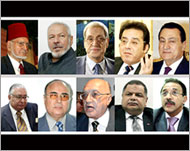Egypt’s election explained
Egypt conducts its first contested presidential election on Wednesday.

The vote is being organised by a newly-formed electoral commission made up of magistrates. According to the commission, the election will proceed as follows:
Voters
About 32 million eligible voters 18 or older are registered on the country’s electoral roll. There are no arrangements for overseas voting.
Voters casting their ballot in the constituency where they are registered do not need to show their polling card and can produce official identification papers such as a driving licence or an identity card instead.
Those choosing to vote outside their constituency must show their polling card.
Polling stations
A total of 9865 polling stations will open on Wednesday, including more than 400 in Cairo, from 8am (0500 GMT) to 8pm (1700 GMT).
Polling hours may be extended if would-be voters are still queuing after 8pm.
 |
|
Ten candidates are vying in Egypt’s |
The number of ballot boxes is limited to five per polling station.
At least one judge supervises the voting in every polling station and each candidate is authorised to have a representative observe the vote.
Voters cast their ballots behind a curtain and then dip their thumbs in pink indelible ink.
The judiciary approved the presence of independent monitors from Egyptian non-governmental groups, but the electoral commission, described as “all-powerful” in matters concerning the vote, has said it will ignore the ruling.
It is still unclear how the sensitive supervision process will play out, although some groups have said they plan to deploy undercover monitors.
Ballot papers
About 32 million ballot papers have been printed. The rectangular slip reads “ballot paper to elect the president of the republic”. The names of the 10 candidates are listed one after the other with a corresponding symbol, number and blank box. Voters tick the box of their choice.
A ballot paper is considered void if no box is ticked, if more than one box is ticked, if voters write their names on it or if they fail to use a pen with dark ink – black or blue.
The count
Judges start counting the votes as soon as the polling stations close. The ballot papers are then transferred to the electoral commission’s central committees to be recounted by other judges.
The central committees inform the commission of the results and hand over the ballot papers. A last computerised tally is carried out by the electoral commission before the results are announced.
Candidates’ representatives can observe all three stages of the count.
The results
The electoral commission is the sole authority that can announce the official results. Polling stations and central committees can disclose partial results.
The commission has up to three days to announce the final results.
Candidates can lodge complaints with the electoral commission until the official announcement.